Hola una vez más.
Hi again.
En el siguiente enlace podéis ver nuestros próximos viajes fotográficos y de observación de aves y mamíferos nacionales y al extranjero. Espero que os gusten y os animéis a venir conmigo. Una experiencia que nunca olvidareis.
Hi again.
En el siguiente enlace podéis ver nuestros próximos viajes fotográficos y de observación de aves y mamíferos nacionales y al extranjero. Espero que os gusten y os animéis a venir conmigo. Una experiencia que nunca olvidareis.
In the following link you can see our next national and foreign Birds and Mammals photographic and observation trips. I hope you like them and I encourage you to come with me. An experience that you will not forget.
En esta entrada os muestro algunas aves que vimos en dos excursiones para fotografiar al bengalí rojo (Amandava
amandava). La primera la realicé el 27 de julio y la segunda el 29 del mismo més. La primera fue solo de mañana y la segunda, por la mañana estuvimos en el Parque y por la tarde fuimos a ver grandes rapaces a la Sierra Oeste de Madrid.
In this post I show you some birds that we saw in two excursions to photograph the Red Avadavat. The first I did on July 27 and the second on the 29th of the same month. The first was only in the morning and the second, in the morning we went to this same Park and in the afternoon we went to see Great Raptors in the Sierra Oeste of Madrid.
In this post I show you some birds that we saw in two excursions to photograph the Red Avadavat. The first I did on July 27 and the second on the 29th of the same month. The first was only in the morning and the second, in the morning we went to this same Park and in the afternoon we went to see Great Raptors in the Sierra Oeste of Madrid.
El objetivo principal era fotografiar a los bonitos bengalíes rojos (Amandava amandava) que son una especie invasora y que se ha establecido desde hace muchos años en esta parte de la Comunidad de Madrid. Esta especie es originaria de Asia y debido a escapes de colecciones y a su gran adaptabilidad han prosperado en bastantes lugares de la geografía Española.
The main target was to photograph the beautiful Red Avadavat which are an invasive species that has been established for many years in this part of the Community of Madrid. This species is native of Asia and due to scapes from collections and their great adaptability have prospered in many places of the Spanish geography.
El motivo de ir en esta época es que su ciclo reproductor sigue coincidiendo con el tiempo de los Monzones en su lugar de origen que es cuando llueve y se reproducen. De finales de julio hasta finales de noviembre los macho están muy activos y en plumaje nupcial por lo que es más fácil localizarlos y fotografiarlos.
The reason of going at this time is that their reproductive cycle continues to coincide with the time of the Monsoons at their place of origin that is when it rains and they reproduce. From late July to late November males are very active and in breeding plumage so it is easier to spot and photograph them.
El tiempo fue bueno en ambas fechas pues no hizo mucho calor.
The weather was good on both dates because it was not very hot.
27 de Julio:
July 27th:
El primer ave que vimos en este día fue esta focha común (Fulica
atra).
The first Bird we saw on this day was this Common Coot.
Los carriceros comunes (Acrocephalus scirpaceus) nos hicieron pasar un rato muy entretenidos.
Reed Warblers made us have a very entertaining time.
Vimos muchos aviones zapadores (Riparia
riparia) pero ninguno se quiso posar cerca.
We saw many Sand Martin but none wanted to perch nearby.
Y las últimas de carricero común (Acrocephalus scirpaceus) ahora con mejor luz.
And the last of Reed Warbler now with better light.
Una preciosa golondrina común (Hirundo
rustica).
A beautiful Barn Swallow.
Aunque ya habíamos visto bengalí rojo (Amandava
amandava) al final decidí cambiarme de sitio pue no los habíamos fotografiado como a mi me gusta. En el nuevo destino tuvimos mucha mejor suerte con esta bella ave.
Although we had already seen Red Avadavat at the end I decided to change the place where we were because we had not photographed them as I like. In the new destiny we had much better luck with this beautiful Bird.
Algunos aún no no habían mudado al cien por cien a el plumaje nupcial.
Some had not yet moved 100 percent to the nuptial plumage.
Este fue el ejemplar que posó más descaradamente para nuestras cámaras.
This was the specimen that posed most blatantly for our cameras.
Esta fue la única hembra que pude fotografiar y para colmo tenía los ojos cerrados.
This was the only female I could photograph and to top her eyes were closed.
Cuando el cliente ya se había quedado satisfecho con las fotografías que habíamos obtenido, decidimos dar una breve vuelta por la zona a ver que otras aves podíamos ver y fotografiar. En la foto un grupo de moritos comunes (Plegadis
falcinellus).
When the client had already been satisfied with the photographs we had obtained, we decided to take a brief tour of the area to see what other Birds we could spot and photograph. The photo shows a flock of Glossy
Ibis.
Dos de ellos estaban anillados pero no pudimos ver los números de las anillas.
Two of them were ringed but we couldn't see their ring number.
Juvenil de garza imperial (Ardea purpurea). Vimos muchas entre jóvenes y adultas.
Purple Heron juvenile. We saw many among young and adults.
Adulta.
Adult.
También vimos un ibis sagrado (Threskiornis
aethiopicus). El ejemplar que tiene el cuello y cabeza negro en el centro de la imagen. Fue una pena que no quisiese estar más cerca nuestro. No es un ave que se vea muy a menudo en la comunidad de Madrid.
We also saw a Sacred Ibis. The specimen with the black head and neck in the center of the image. It was a shame he didn't want to be closer to us. It is not a Bird that is seen very often in the Community of Madrid.
Hembra de libélula flecha roja (Sympetrum sanguineum).
Female of Ruddy Darter.
También vimos varios aguiluchos laguneros occidentales (Circus
aeruginosus).
We also saw several Eurasian Marsh
Harrier.
Abejaruco europeo (Merops
apiaster).
European
Bee-eater.
Juvenil de cigüeña blanca (Ciconia
ciconia).
White
Stork juvenile.
Y para finalizar este medio día esta pareja de cigüeñuelas comunes (Himantopus
himantopus).
And to end this half day this pair of Black-winged
Stilt.
29 de julio:
July 29:
Este dia comenzo como el anterior. Vimos muchos carriceros comunes (Acrocephalus scirpaceus) si bien no tomé tantas fotos pues tenía muy reciente el viaje anterior en el que ya tenía muy buenas fotos.
This day began as the previous one. We saw many Reed Warbler although I did not take so many photos because I had very recent the previous trip in which I already had very good photos.
En este caso quien se posó cerca de donde estábamos fue un joven de golondrina común (Hirundo
rustica).
In this case who landed near where we were was a juvenile Barn
Swallow.
Y este otro. Tienen mucho menos colorido que los adultos.
And this one. They are much less colorful than adults.
Hembra de gorrión común (Passer
domesticus).
House
Sparrow female.
Vimos a este adulto de zampullín común (Tachybaptus
ruficollis), por cierto muy guapo él, con dos pollos.
We saw this adult of Little
Grebe, by the way very handsome, with two chicks.
Uno de ellos.
One of them.
El otro iba un poco más rezagado.
The other was a little more behind.
Como en el día anterior vimos muchos bengalíes rojos (Amandava
amandava). Este no estaba aún muy bonito.
As on the previous day we saw many Red Avadavat. This one wasn't very pretty yet.
Un Carricero tordal (Acrocephalus arundinaceus).
A Great
Reed Warbler.
Este fue el macho de bengalí rojo (Amandava amandava) que más cerca tuvimos.
This was the Red Avadavat male that we had closest.
Aunque este tampoco estuvo muy lejos.
Although this was not too far iether.
Preciosa ave.
Beautiful Bird.
Y este el que estaba completamente en plumaje nupcial.
And this which was completely in breeding plumage.
Macho de libélula flecha roja (Sympetrum sanguineum).
Male of Ruddy Darter.
Mientras nos dirigíamos al otro destino pudimos ver algunas otras aves como garcilla bueyera (Bubulcus
ibis).
While we were going to the other destination we could see some other birds like Cattle Egret.
Avefría europea (Vanellus
vanellus).
Northern
Lapwing.
Solo vimos un morito común (Plegadis
falcinellus).
We only saw a Glossy
Ibis.
Y como en el día anterior muchas garzas imperiales (Ardea purpurea).
And as in the previous day many Purple
Herons.
Y alguna garza real (Ardea
cinerea).
And some Gray Heron.
También vimos varios grupos de abejaruco europeo (Merops
apiaster).
We also saw several flocks of European Bee-eaters.
Después de comer llegamos a la Sierra Oeste y lo primero que vimos fue este joven de águila imperial ibérica (Aquila
adalberti).
After lunch we arrived at the Sierra Oeste and the first thing we saw was this juvenile Spanish Imperial Eagle.
Vimos mucho buitres leonados (Gyps
fulvus).
We saw many Griffon
Vultures.
Un juvenil de escribano montesino (Emberiza
cia).
A juvenile of Rock
Bunting.
Solo vimos este subadulto de águila real (Aquila
chrysaetos).
Only we saw this subadult Golden Eagle.
Algunos buitres leonados (Gyps
fulvus) pasaron bastante cerca.
Some Griffon Vultures passed quite close.
Al igual que algunos buitres negros (Aegypius
monachus).
Like some Black Vultures.
También vimos dos subadultos de águila imperial ibérica (Aquila adalberti). Este es uno de ellos.
We also saw two subadults of Spanish Imperial Eagle. This is one of them.
Y este el otro.
And this the other one.
Y ya cuando nos íbamos del lugar tuvimos la suerte de ver a un adulto posado en una torreta eléctrica.
And when we left the place we were lucky to see an adult perched on an electric pylon.
En el camino de vuelta nos encontramos con estos dos sisones comunes (Tetrax
tetrax).
On the way back we find these two Little
Bustards.
Un bonito regalo de despedida del día.
A nice goodbye gift of the day.
Hasta pronto.
See you soon.


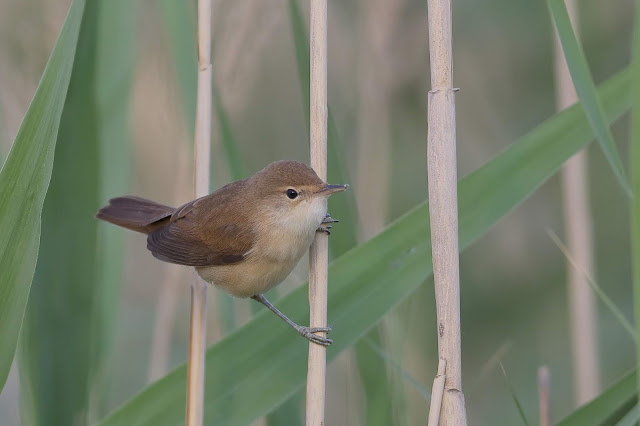





















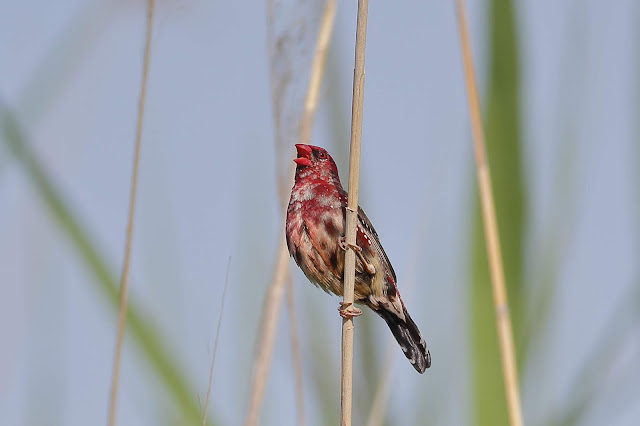
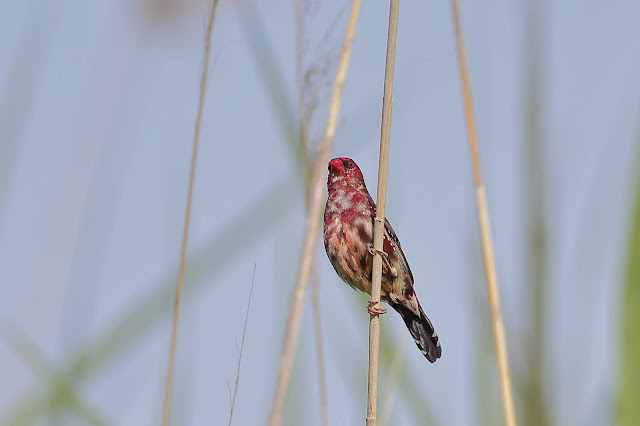












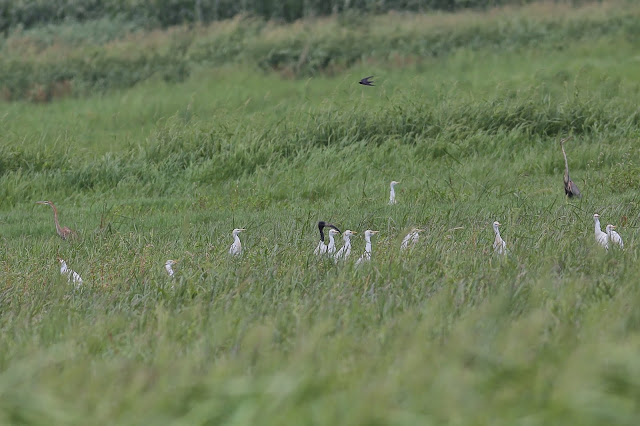







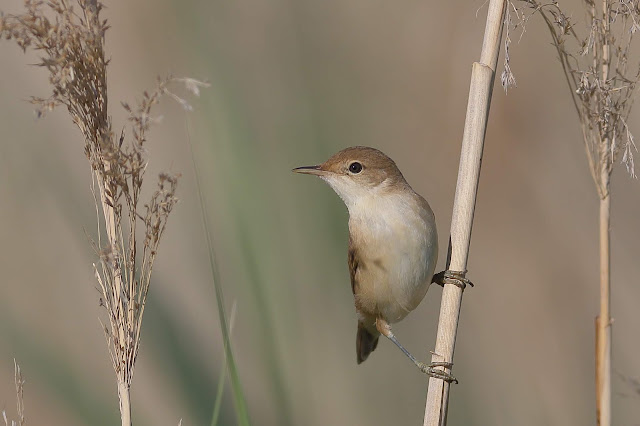













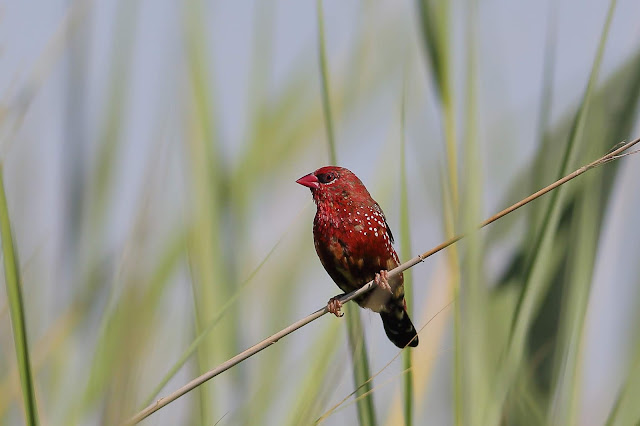














































No hay comentarios:
Publicar un comentario